Shin pain in an adolescent soccer player: A case-based look at "shin splints"
A 14-year-old high school soccer player, referred by her pediatrician, has been brought to the sports medicine clinic reporting a one-year history of "shin splints." She describes shin pain in both legs that seems to increase with running and brisk walking, mostly over the "front" of her shins. She characterizes her pain as a "tightness" that "pinches" her legs and becomes noticeable five to seven minutes after she begins activity. The pain has become more intense the past two months--to the point where she is unable to run for more than 10 minutes at a time.

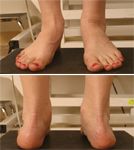
The medical history reveals mild asthma that is treated with a β-agonist medication. She has no significant orthopedic history. Her dietary history is noteworthy for inadequate calcium intake (approximately 1,000 mg/day), and her menstrual history is remarkable for onset of menses at age 13. Since that time, she has had monthly cycles. There is no family history of osteoporosis.
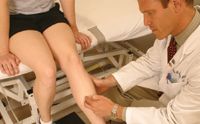
Differential diagnosis



To understand specific types of bone injury, it is important to understand the way in which bone is altered. Normally, bone responds to changes in loading patterns with an increase in metabolic activity or bone remodeling known as Wolfe's law. At a microscopic level, remodeling occurs in a well-defined pattern. When bone encounters new and sustained mechanical stress, osteoclasts remove old bone matrix, creating pores in the bony framework. Next, osteoblasts deposit new bone matrix into the pores. The rate of bone formation should equal the rate of bone resorption. Under pathologic circumstances, porous bone cannot accommodate continuous loading, resulting in microfissures that can progress to stress fracture.5
The other main classification of shin splint pain is related to overuse of muscle, which often goes undiagnosed for a long time because the pain takes more time to become acute and limit activity compared with bone pain. The muscular type of shin pain is known as (chronic) exertional compartment syndrome (ECS). Unlike bone-related shin pain, which tends to hurt on palpation of the tibia, in ECS there is generally no bone pain on palpation. ECS involves a tightening, restrictive pain that becomes worse with activity. This is believed caused by increased pressure within the compartment during activity.
We will consider both types of shin pain as we explore the differential diagnosis in the patient whose case has just been described-a differential that includes MTSS, tibial stress fracture, peripheral neuropathy, lumbar radiculopathy, and ECS.
Medial tibial stress syndrome MTSS is the most common cause of shin pain in athletes, especially those who participate in repetitive activities such as running and jumping; its exact incidence is unknown.6 Clinical diagnosis is made by history and physical examination. Diffuse pain and tenderness across the posterior-medial aspect of the tibia, normal radiographs, and the absence of neurologic findings are usually adequate to make the diagnosis.7 Michael and Holder,8 in their definition of MTSS, include clinical characteristics of dull aching to intense pain that is alleviated by rest; tenderness over the posterior-medial border of the tibia; and the absence of neurovascular abnormalities.
Early in the disorder, pain occurs at the beginning of a workout but resolves during activity, only to return upon completion of exercise. In later stages, pain is often sharper and occurs throughout the workout. In a severe case, the person may experience pain throughout the day and sometimes at rest.
Physical exam. Patients with MTSS usually complain of diffuse pain along the middle and distal thirds of the posterior-medial tibia. (This contrasts with tibial stress fracture, in which there is a single area of point tenderness at which a fracture has occurred.) Palpation of the tibia elicits pain; Figure 2 identifies the point at which a patient would have pain if she has MTSS. The pain of MTSS can sometimes also be elicited by maneuvers that stretch or contract the soleus, such as plantar flexion against resistance, passive ankle dorsiflexion, standing on tiptoes, and hopping or jumping in place.
Diagnostic studies. Radiographs are usually normal in MTSS. Most cases are diagnosed based on history and clinical examination alone, and further studies are usually unnecessary. If the diagnosis is unclear, however, magnetic resonance imaging may be warranted to rule out tibial stress fracture. MRI can show medullary edema in some cases of advanced MTSS, but is usually not needed in treating MTSS.
Treatment includes a period of relative rest, the length of which varies depending on the patient and the severity of bone pain; three to four weeks is a general estimate. Because MTSS can develop into a stress fracture if the athlete is allowed to "run through the pain," we generally don't recommend nonsteroidal anti-inflammatory drugs in patients with bone injuries, as they diminish the symptoms. Ice is helpful both as an analgesic and anti-inflammatory agent with each of the conditions discussed in this article, and should be used for 15 minutes an hour as initial therapy.
Variables that led to the bone overload injury need to be assessed, including foot biomechanics (pronation), training level, running surface, and shoes. Many of these variables can be changed to prevent repeat injury; measures include corrective orthotics and exercise shoes designed to limit motion in the foot when it makes contact with the ground.
Tibial stress fracture Along the continuum of bone overuse injury, tibial stress fracture represents a more serious injury than MTSS, although the presentation of the two conditions is very similar. Tibial stress fracture often occurs in running and jumping sports. The pain usually begins as a dull ache during training, progressing to severe pain throughout the day and night. As in MTSS, a patient may have pain at the posterior-medial margin of the tibia.
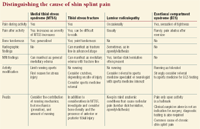
The pain of tibial stress fracture can occur in the posterior-medial tibia (Figure 2) or in the anterior tibia (Figure 3). Of these two sites, the anterior tibial stress fracture is more clinically worrisome because of the distraction forces that are displaced on the tibia with running. Anterior tibial stress fractures occur on the convex side of the tibia and are known as tension-side injuries because they displace further with the force of walking and running. Anterior injuries generally require more aggressive management, including a period of non-weight bearing, and should be referred to a sports-oriented orthopedist or sports medicine specialist.
Physical exam. Extreme point tenderness on palpation is the most important physical finding of tibial stress fracture. Patients often exhibit tenderness at the posterior-medial margin of the tibia near the middle and distal thirds of the bone.9 The gait is often hesitant and the patient can be reluctant to bear full weight on the injured extremity. The hop test is generally positive-the tibia is painful when the patient lands on the leg.
Diagnostic studies. Although plain radiographs are often normal, they are still the initial diagnostic imaging technique of choice. In the early phase, the fracture may appear as lucency in compact bone, in contrast to the more radiopaque appearance of cancellous bone. The gray cortex sign (a focal area of graying of the cortex) has been described as an early sign of stress injury.10
Bone scans have long been the standard for diagnosis of stress fracture. However, because of the time, cost, radiation exposure, and inability of bone scan to show medullary edema or a fracture line in bone (findings used to distinguish a stress injury from a stress fracture), MRI has replaced bone scan as the study of choice for the diagnosis of overuse injury to bone.9
Treatment. Stress fracture of the tibia can be viewed as a more advanced stage of MTSS. Any stress fracture, particularly an anterior-tibial stress fracture, should be referred to a specialist. Depending on the site of injury, treatment varies from a period of limiting activity that stresses the bone and engaging in cross-training (swimming is a great way to maintain cardiovascular fitness while not loading the bone), to a four- to six-week period of non-weight bearing on crutches. In general, if a bone injury is still painful, either to palpation or with bone loading during the hop test, then the injury has not been fully treated and requires more time to completely heal.
Bone density is an important contributing factor in stress fractures in adolescents and young adults and should be addressed in addition to biomechanical issues and pronation. Variables that can undermine adolescent bone density include inadequate calcium intake (less than 1,500 mg/day); amenorrhea for longer than five or six menstrual cycles; and a family history of osteoporosis. When amenorrhea, osteoporosis, and anorexia occur together, they are collectively known as the female athlete triad. Increasingly, dual energy X-ray absorptiometry (DEXA) is being used to obtain a baseline bone density value for the adolescent suspected of having osteoporosis, although this is not an official recommendation of the American Academy of Pediatrics. Supplements should be recommended if the patient is not getting the 1,500 mg/day of calcium, and 400 IU/day of vitamin D, recommended by the AAP for growing teenagers.
Peripheral neuropathy Although very rare in children and adolescents, nerve compression or entrapment can cause lower extremity pain in active young children. The common peroneal nerve can be compressed where it passes around the fibular head. In such a case, the history and physical exam suggest pain in this area and electrodiagnostic studies can pinpoint the exact location of the lesion. The pain of peripheral neuropathy tends to be more like muscle-related pain than bone related (nonfocal pain and no pain on palpation of bone).
Leach and colleagues11 reported on a group of seven runners and one soccer player with peroneal nerve compression neuropathy secondary to exercise. Running incited pain, numbness, and tingling to varying degrees in all patients, and examination after running revealed muscle weakness and a positive percussion test where the nerve winds around the fibular neck. The diagnosis was confirmed by nerve conduction velocity studies in the five patients on whom the test was performed; other studies served primarily to exclude other causes of pain.
The superficial peroneal nerve may be affected by a muscle tear or by any recent trauma, particularly an ankle sprain.12 The nerve is most commonly compressed as it exits the deep fascia to become subcutaneous. There may be focal tenderness in the area where the nerve exits (11 cm above the medial malleolus) while the patient dorsiflexes and averts. The patient will complain of activity-related pain. Weakness may be present.
Lumbar radiculopathy The probability of spinal stenosis is extremely low in a young athlete; patients suffering from spinal stenosis are almost always middle age or older. They often have a history of low back pain, with a newer onset of lower extremity pain. As with peripheral neuropathy, the pain of lumbar radiculopathy tends to be more like muscle-related pain than bone related. The history and physical are crucial to diagnosis.
Symptomatic disk herniation can be found in all age groups, with a peak incidence in patients between 35 and 45. Given that the patient whose case is described here is a young athlete with a complaint of lower leg pain, taking a short patient history aimed at uncovering a possible herniated disk is well worth the time. A physical exam can help rule in or rule out this diagnosis. Sciatica, characterized by pain radiating down the leg in a dermatomal pattern, is found in as many as 40% of patients with lumbar disk herniation.13 The patient with disk herniation will often complain of pain with bending forward and when straightening the leg, the action mimicking the straight leg test. Discogenic back pain is generally confirmed with an MRI scan.
Disk herniation is usually preceded by degenerative changes inside the disk. Tears in the annulus progress to radial tears that can ultimately lead to disk herniation or disruption. In a noncontained disk herniation, the annulus becomes completely disrupted. In a contained disk protrusion, the annulus fibers remain intact. The pain often associated with disk herniation can be caused by pressure on the nerve root or from breakdown products of a degenerated nucleolus pulposus.
The treatment of discogenic back pain in the adolescent begins with physical therapy to reduce the muscular forces around the lumbar spine. Surgery is rarely necessary in adolescents.
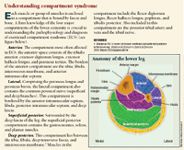
Each muscle or group of muscles is enclosed in a compartment bound by fascia and bone. The box on the left shows and describes the four major compartments of the lower extremity. In compartment syndrome, perfusion pressure falls below tissue pressure in a closed anatomic compartment, with subsequent compromise of vascular supply and tissue function. ECS results from the repetitive loading or exertional activity that an athlete experiences on a daily basis. The pathophysiology of ECS is incompletely understood, but it is generally accepted that elevated intracompartmental pressure causes ischemia of involved muscles.14 Elevated intracompartmental pressures have been found both during and after exercise in patients with ECS.15 Several studies have demonstrated a reduction in intracompartmental pressure after fasciotomy.16,17
Case in point The 14-year-old soccer player whose case is described at the beginning of this article displays a typical presentation of ECS. She complains of "tightness" over her shins that becomes worse with exercise. Some patients may also describe the discomfort as a "cramping" sensation of the affected extremity with exercise. It is important to realize that the intense pain of ECS ceases when the patient stops activity. Pain is usually described as constant during exercise, and is unrelated to ground contact, as opposed to the discomfort of a tibial stress injury. Nonsteroidal anti-inflammatory medications are largely ineffective.
Physical exam.A hallmark feature of ECS is that the physical exam, performed with the patient at rest, is completely normal. Unlike cases of tibial overload, there is no bone tenderness to palpation. ECS can, however, occur simultaneously with a tibial stress injury-in which case there will be tibial tenderness as well as firmness and pain over the affected compartment during running. The patient will often describe "tightness" over the front of the lower leg-more than 80% of ECS cases involve the anterior compartment.18
The neurosensory examination is usually not helpful in the patient with ECS, as it is usually normal.
Diagnosis. The history is the key component. It is essential for the clinician to listen for a description of leg tightness and pain that occur only with exertion and disappear afterward. Unlike bone-related pain, ECS does not produce symptoms without exertion. In addition, whereas radiographs, MRI, and bone scan help show bone injuries such as tumors and overuse injury to bone, these tests are normal in cases of ECS.
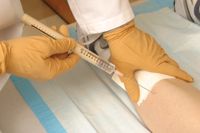
Pedowitz and colleagues defined criteria for diagnosis of anterior (the most common) chronic ECS in the leg.18 These include one or more of the following:
Treatment. The initial treatment for ECS, as diagnosed by compartment pressure testing, is rest and physical therapy. In many cases, however, this approach fails. Any case of ECS that does not respond to rest and physical therapy should be referred.
The treatment of choice for ECS is elective fasciotomy of the affected compartment.17,19 Surgical therapy is based on the belief that intracompartmental pressure needs to be decreased. This is done by releasing the fascial barrier of the involved compartment through fasciotomy. Results from ECS surgery are generally good, with reports of symptomatic cure or improvement in most cases.16
Our 14-year-old soccer player was given a diagnosis of ECS in the anterior compartment of both legs. She underwent bilateral, anterior fasciotomy in April and by the middle of June was practicing with her summer soccer team-at full effort!
REFERENCES 1. Batt ME: Shin splints: A review of terminology. Clin J Sport Med 1995;5(1):53
2. Bates P: Shin splints: A literature review. Br J Sports Med 1985;19(3):132
3. Couture C, Karlson KA: Tibial stress injuries.The Physician and Sportsmedicine 2002;30(6):26
4. Beck BR: Tibial stress injuries: An aetiological review for the purposes of guiding management. Sports Med 1998;26(4):265
5. Johnell O, Rausing A, Wendeberg B, et al: Morphological bone changes in shin splints. Clin Orthop 1982; 167(Jul):180
6. Korkola M, Amendola A: Exercise induced leg pain. The Physician and Sportsmedicine 2001;29(6):35
7. Brahms MA, Fumich RM, Ippolito VD: Atypical stress fracture of the tibia in a professional athlete. Am J Sports Med 1980;8(2):131
8. Michael RH, Holder LE: The soleus syndrome: A cause of medial tibial stress (shin splints). Am J Sports Med 1985;13(2):87
9. Callahan LR: Stress fractures in women. Clinics in Sports Medicine 2000;19(2):303
10. Mulligan ME: The “gray cortex”: An early sign of stress fracture. Skeletal Radiol 1995 Apr;24(3):201
11. Leach RE, Purnell MB, Saito A: Peroneal nerve entrapment in runners. Am J Sports Med 1989 Mar-Apr; 17(2):287
12. Baxter DE: Functional nerve disorders in the athlete's foot, ankle, and leg. Instr Course Lect 1993;42:185
13. Porchet F, Fankhauser H, de Tribolet N: Extreme lateral lumbar disc herniation: Clinical presentation in 178 patients. Acta Neurochir (Wien) 1994;127: 203
14. Amendola A, Rorabeck CH: Chronic exertional compartment syndrome, in Current Therapy in Sports Medicine, RP Welsh, RJ Shepard, et al (eds), Toronto, B. C. Decker, 1985, pp 250–252
15. Reneman RS: The anterior and the lateral compartmental syndrome of the leg due to intensive use of muscles. Clin Orthop Relat Res 1975;113:69
16. Rorabeck CH, Bourne RB, Fowler PJ: The surgical treatment of exertional compartment syndrome in athletes. J Bone Joint Surg 1983;65A:1245
17. Slimmon D, Bennell K, Brukner P, et al: Long-term outcome of fasciotomy with partial fasciectomy for chronic exertional compartment syndrome of the lower leg. Am J Sports Med 2002 Jul-Aug;30(4):581
18. Pedowitz, RA, Hargens AR, Mubarak SJ, et al: Modified criteria for the objective diagnosis of chronic compartment syndrome of the leg. Am J Sports Med 1990;18:35
19. Howard JL, Mohtadi NG, Wiley JP: Evaluation of outcomes in patients following surgical treatment of chronic exertional compartment syndrome in the leg. Clin J Sport Med 2000 Jul;10(3):176
Having "the talk" with teen patients
June 17th 2022A visit with a pediatric clinician is an ideal time to ensure that a teenager knows the correct information, has the opportunity to make certain contraceptive choices, and instill the knowledge that the pediatric office is a safe place to come for help.
Artificial intelligence improves congenital heart defect detection on prenatal ultrasounds
January 31st 2025AI-assisted software improves clinicians' detection of congenital heart defects in prenatal ultrasounds, enhancing accuracy, confidence, and speed, according to a study presented at SMFM's Annual Pregnancy Meeting.